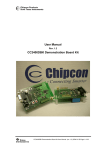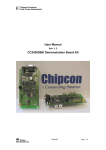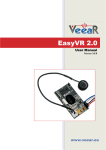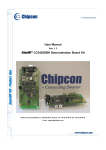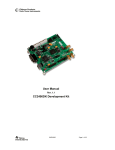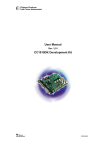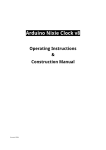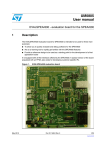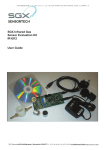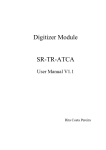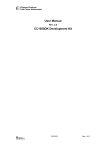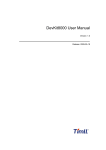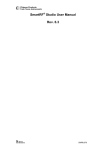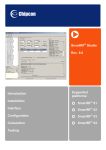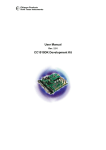Download User Manual CC2400DBK Demonstration Board Kit
Transcript
User Manual Rev. 1.2 CC2400DBK Demonstration Board Kit SWRU048 Page 1 of 30 Table of contents INTRODUCTION ....................................................................................................................... 3 PCB ........................................................................................................................................... 4 RF SECTION ............................................................................................................................ 4 ANTENNA ................................................................................................................................. 4 POWER SUPPLY SECTION .......................................................................................................... 7 RS-232 INTERFACE .................................................................................................................. 8 MICROCONTROLLER AND USER INTERFACE ................................................................................ 8 PCB LAYOUT ......................................................................................................................... 11 USING THE CC2400DB DEMONSTRATION BOARD .......................................................... 22 CC2400 SOFTWARE DOWNLOAD AND EVALUATION USING AVR STUDIO 4 ................................. 22 RC OSCILLATOR ..................................................................................................................... 23 MICROCONTROLLER EEPROM MAPPING ................................................................................. 23 IN SYSTEM PROGRAMMING ..................................................................................................... 24 BOOTLOADER ......................................................................................................................... 25 INTRODUCTION TO EXAMPLES PROVIDED WITH CC2400DB ...................................................... 26 SETTING UP A SOFTWARE PROJECT FOR CC2400 .................................................................... 27 HARDWARE DEFINITION FILES (HDF) ...................................................................................... 27 HARDWARE LIBRARY FILES (HLF)........................................................................................... 27 CONFIGURE OUTPUT PROFILE.................................................................................................. 28 DATA PACKET DESCRIPTION .................................................................................................... 28 DATA TRANSMISSION PROTOCOL ............................................................................................. 28 TROUBLESHOOTING ............................................................................................................ 29 IT DOES NOT WORK ................................................................................................................. 29 I CANNOT PROGRAM THE AVR USING THE SERIAL PORT ............................................................ 29 REFERENCES ........................................................................................................................ 29 SWRU048 Page 2 of 30 Introduction The CC2400 single-chip RF transceiver provides a highly integrated, flexible low-cost solution for applications using the world wide unlicensed 2.4 GHz frequency band. The CC2400DBK demonstration board kit is a complement to the development kit (DK) as the hardware is representative of an actual application, and it is well suited as a prototyping platform for application code. The CC2400DBK Demonstration Board Kit includes two CC2400DB Demonstration Boards. These boards contain a CC2400 with necessary support components, an Atmel mega8 AVR microcontroller, a PCB antenna, as well as a joystick, buttons and LEDs that can be used to implement a visual user application interface. The demonstration board is also furnished with connectors where all of the internal signals on the PCB are available. This User Manual describes how to use the CC2400DBK Demonstration Board Kit. Atmel’s AVR Studio and associated software is used to program and debug software. Please see the reference section of this document for links to Atmel’s documentation on how to use their tools. Your CC2400DBK Demonstration Board Kit should contain the following items: Kit contents Item Number of articles Demonstration Board (CC2400DB) 2 Quick Start instructions 1 CC2400 sample kit 1 RS-232 cables 2 Important: Contact your local telecommunication authorities before transmitting an RF signal to ensure that there are no local restrictions on the use of the 2400 –2483.5 MHz ISM band. The CC2400 operates in the 2.4 GHz frequency band. Although this frequency band is usually described as “world-wide”, some countries do not allow unlicensed operation in this band. SWRU048 Page 3 of 30 PCB Figure 1 depicts an overview of the CC2400DB with description of the various components embedded on the PCB. Joystick MCU section RS-232 port PCB antenna 4-10 V DC-jack CC2400 RF section buttons 3.3V voltage regulator 1.8V voltage regulator Optional 9V battery Leds Temp. sensor Figure 1: CC2400DB overview RF Section The CC2400DB RF section includes all the necessary components for correct operation. The CC2400 is connected to a 16 MHz crystal. A small 2.4 GHz PCB antenna is also included. RF test and measurement equipment can be mounted the PCB by the use of an SMA connector, by swapping capacitor placement of C63 and C62. See schematics for details. The RF layout is identical to the CC2400EM, which is part of the CC2400DK Development Kit. Important: The CC2400DB demonstration board output power must be reduced for a 100% transmission nd duty cycle to be compliant with the FCC 15 2 harmonics regulation requirement. At the moment the design is 1 dB above the limit. Antenna The PCB antenna is a so-called Inverted-F type. The Inverted-F antenna is a wire monopole where the top section is folded down to be parallel with the ground plane. By folding the antenna down you will reduce the height and maintain a resonant wire length. A capacitance will be introduced to the input impedance of the antenna due to the parallel section. However, as a rule of thumb design guide, the length + height (L+H) will be approximately equal to a SWRU048 Page 4 of 30 quarter wavelength (λ/4). A reduction of the antenna height (H) will in general decrease the antenna bandwidth. Please see figure 3 for the antenna dimensions. Figure 2: Antenna dimensions The height of the antenna is defined as the distance from the ground plane to the parallel section, and the length is from the end of the antenna parallel section to the feed point. Length: L = (26.19 mm – 9.19 mm + 1.22 mm x ½) = 17.61 mm Height: H = (6.17 mm + 0.97 mm - 1.19 mm x ½) = 6.55 mm Quarter wavelength: λ/4 = (L + H) = 17.61 mm + 6.55 mm = 24.16 mm The physical size of the antenna is decreased somewhat compared to the theoretical length, (λ = c/4*f = 3x108 / 4x2.45x109) = 30.61 mm SWRU048 Page 5 of 30 The radiated pattern for the PCB antenna was measured with the horizontal polarization direction for the CC2400DB by measuring with vertical and horizontal mounting of the demonstration board. Important: In practical range testing outdoors with line-of-sight (LOS) and use of the rfBlinkLed application example, the following range has been verified at Chipcon Norway with optimal SmartRF Studio settings for the respective data rates: 1. Data rate settings 1 Mbps, range measured: 140 meters 2. Data rate settings 250 kbps, range measured: 240 meters Please note that these range tests were performed at 0° C with a simple packet protocol, no link margin, no robust protocol, close to the sensitivity limit of CC2400, and no retransmission. 0 degr. Antenna CC2400DB Top view Figure 3: Radiated pattern horizontal mounting SWRU048 Page 6 of 30 Figure 3 depicts the antenna pattern while the CC2400DB is mounted horizontally with the antennas parallel section aligned to the 0 degree direction. 0 degr. Antenna CC2400DB Top view Figure 4: Radiated antenna pattern vertical mounting Figure 4 depicts the antenna pattern while the CC2400DB is mounted vertically with the antennas parallel section aligned to the 0 degree direction. Power supply section The power supply section contains two voltage regulators: a 3.3 V regulator for use by the microcontroller and the I/O pins of the CC2400, and a 1.8 V regulator for powering the CC2400 core. A diode prevents permanent damage if wrong polarity is applied to the board. There are two power connectors; a 2.5mm DC jack-type connector allows you to connect an unregulated battery eliminator easily (the positive supply is on the center pin), and a connector for a 9V battery on the bottoms side of the PCB. It is also possible to use 3 or 4 AA or AAA alkaline cells to power the CC2400DB if a suitable battery pack is used. SWRU048 Page 7 of 30 RS-232 interface A serial port is included on the CC2400DB. This port is used when software is programmed into the AVR MCU using the boot loader, and is also used by several of the example programs. The port includes support for RTS/CTS-type hardware flow control (handshaking). Important: It is important to be aware that maximum data rate for the Atmega8 RS-232 interface on CC2400DB is 38.4 Kbps due to the use of the internal RC oscillator. Please see the Atmega8 datasheet for a baud rate error overview with the respect to a selected oscillator frequency. Microcontroller and user interface The microcontroller used is an AVR Atmega8L from Atmel. This controller has 8 KB of Flash program memory, 1 KB of SRAM data memory and 512 bytes of non-volatile EEPROM data memory. The controller runs on its internal oscillator, and is interfaced to the CC2400 via its built-in SPI interface as well as some general I/O pins. The MCU is also connected to three LEDs, a joystick and an extra button for user interface purposes. The different examples use these peripherals differently. An analog temperature sensor is also included. An ISP connector is provided for programming the AVR without using the serial port. In this case an Atmel AVR programmer should be connected to this connector. All of the I/O pins are connected to footprints for 2 x 10 pin-row connectors. These connectors are compatible with Agilent logic analyzer probes, and can be used either for testing or for prototyping. For instance, it is possible to add a daughter board with additional circuitry using these connectors. AVR Pin Number AVR pin name Pin usage I/O connector 1 PD3/INT1 CC2400 DIO/DKT P4 pin 14 2 PD4/XCK/T0 Yellow LED P4 pin 7 7 PB6/XTAL1/TOSC 1 Joystick up P3 pin 9 8 PB7/XTAL2/TOSC 2 Joystick right P3 pin 7 9 PD5/T1 Joystick down P3 pin 6 10 PD6/AIN0 Joystick left P3 pin 3 11 PD7/AIN1 Joystick center push P3 pin 5 12 PB0/ICP RS-232 handshaking RTS, push button P3 pin 13 13 PB1/OC1A RS-232 handshaking CTS, Red LED P3 pin 17 14 PB2/SS/OC1B CC2400 chip select P4 pin 13 15 PB3/MOSI/OC2 CC2400 SI, AVR ISP P4 pin 8 16 PB4/MISO CC2400 SO, AVR ISP P4 pin 6 17 PB5/SCK CC2400 SCK, AVR ISP P4 pin 4 19 ADC6 Not used P4 pin 11 22 ADC7 Temperature sensor P4 pin 9 23 PC0/ADC0 CC2400 GIO6 P4 pin 10 SWRU048 Page 8 of 30 24 PC1/ADC1 CC2400 GIO1 P4 pin 19 25 PC2/ADC2 CC2400 TX P4 pin 16 26 PC3/ADC3 CC2400 RX P4 pin 18 27 PC4/ADC4/SDA RS-232 on/off P3 pin 11 28 PC5/ADC5/SCL Green LED P4 pin 5 29 PC6/RESET Reset button, AVR ISP P4 pin 3 30 PD0/RXD RS-232 receive data from PC P3 pin 15 31 PD1/TXD RS-232 transmit data to PC P3 pin 19 32 PD2/INT0 CC2400 DCLK/FIFO P4 pin 12 Table 1: AVR I/O pins SWRU048 Page 9 of 30 Pin number Signal name in schematic Pin usage CC2400 pin AVR pin 1 2 3 Unregulated supply voltage PD6 Joystick left 10 (PD6/AIN0) 5 PD7 Joystick center push 11 (PD7/AIN1) 6 PD5 Joystick down 9 (PD5/T1) 7 PB7 Joystick right 8 (PB7/XTAL2/TOSC2) PB6 Joystick up 7 (PB6/XTAL1/TOSC1) FORCE_ON RS-232 on/off 27 (PC4/ADC4/SDA) RTS RS-232 handshaking, push button 12 (PB0/ICP) RXD0 RS-232 data from PC 30 (PD0/RXD) CTS RS-232 handshaking, Red LED 13 (PB1/OC1A) 19 TXD0 RS-232 data to PC 31 (PD1/TXD) 20 GND Ground 4 8 9 10 11 12 13 14 15 16 17 18 Table 2: P3 pinout SWRU048 Page 10 of 30 Pin number Signal name in schematic Pin usage CC2400 pin AVR pin 3 RESET Reset 4 SCLK CC2400 serial clock, AVR ISP 5 PC5 Green LED 6 SO CC2400 SPI out, AVR ISP 7 PD4 Yellow LED 8 SI CC2400 SPI in, AVR ISP 9 ADC7 Temperature sensor 10 GIO6 CC2400 GIO6 11 ADC6 Not used 12 DCLK/FIFO CC2400 DCLK/FIFO 30 (DCLK/FIF O) 32 (PD2/INT0) 13 CSn CC2400 chip select 31 (CSn) 14 (PB2/SS/OC1B) 14 DIO/PKT CC2400 DIO/PKT 29 (DIO/PKT) 1 (PD3/INT1) 15 3.3V 3.3V regulated supply 16 TX CC2400 TX 28 (TX) 25 (PC2/ADC2) 17 1.8V 1.8V regulated supply 18 RX CC2400 RX 27 (RX) 26 (PC3/ADC3) 19 GIO1 CC2400 GIO1 21 (GIO1) 24 (OC1/ADC1) 20 GND Ground 1 2 29 (PC6/RESET) 32 (SCLK) 17 (PB5/SCK) 28 (PC5/ADC5/SCL) 34 (SO) 16 (PB4/MISO) 2 (PD4/XCK/T0) 33 (SI) 15 (PB3/MOSI/OC2) 22 (ADC7) 35 (GIO6) 23 (PC0/ADC0) 19 (ADC6) Table 3: P4 pinout PCB layout RF circuits operating at high frequencies are normally sensitive to the physical layout of the PCB. Chipcon has carefully optimized the layout of the CC2400DB Demonstration Board and we therefore recommend that our customer copy, at least the RF parts and the decoupling around the CC2400 when making their own PCB designs. The PCB is of a 4-layer type in order to provide a well-defined ground plane as well as adequate routing space. The laminate used is standard FR-4 board material. The PCB is 1.0mm thick, with layer 1 on the topside, layers 2 and 3 are internal layers and layer 4 is on the bottom side. Layers 1 and 4 are used for routing, while layer 2 is a ground plane and layer 3 is used for power routing. All areas in the RF section that are not utilized for routing are filled with copper connected to ground to provide RF shielding. The ground planes on all layers are stitched together with closely spaced vias. SWRU048 Page 11 of 30 Layer 1 Layer 2 Layer 3 Layer 4 Figure 5: CC2400DB PCB layout SWRU048 Page 12 of 30 Top Assembly Bottom Assembly Figure 6: CC2400DB PCB layout silkscreen SWRU048 Page 13 of 30 Schematic Figure 7: CC2400DB schematic page 1 SWRU048 Page 14 of 30 Figure 8: CC2400DB schematic page 2 SWRU048 Page 15 of 30 Figure 9: CC2400DB schematic page 3 SWRU048 Page 16 of 30 Figure 10: CC2400DB schematic page 4 SWRU048 Page 17 of 30 Figure 11: CC2400DB schematic page 5 SWRU048 Page 18 of 30 Bill of materials Bill of materials, CC2400DB Top-level section Reference Description Value Part P1 DC jack, 2.5mm center pin DC_JACK_2.5 P2 D-Sub, 9 pin, female DSUB_9F P3 PINROW_2X10 Pin row, 2x10 P3 PINROW_2X10 Pin row, 2x10 R101 Resistor 0603 0Ω Not Mounted Bill of materials, CC2400DB RF Section Reference Description Value Part C1 Capacitor 0603 2.2 uF, 10% C_2U2_0603_X5R_K_10 C11 Capacitor 0402 100 nF, 10% C_100N_0402_X5R_K_10 C61 Capacitor 0402 0.5 pF, ± 0.25 pF C_0P5_0402_NP0_C_50 C62 Capacitor 0402 5.6 pF, ± 0.25 pF Not Mounted C63 Capacitor 0402 5.6 pF, ± 0.25 pF C_5P6_0402_NP0_C_50 C71 Capacitor 0402 100 nF, 10% C_100N_0402_X5R_K_10 C81 Capacitor 0402 0.5 pF, ± 0.25 pF C_0P5_0402_NP0_C_50 C101 Capacitor 0402 10 nF, 10% C_10N_0402_X7R_K_25 C161 Capacitor 0402 68 pF, 5% C_68P_0402_NP0_J_50 C251 Capacitor 0402 100 nF, 10% C_100N_0402_X5R_K_10 C261 Capacitor 0402 100 nF, 10% C_100N_0402_X5R_K_10 C411 Capacitor 0402 68 pF, 5% C_68P_0402_NP0_J_50 C421 Capacitor 0402 27 pF, 5% C_27P_0402_NP0_J_50 C431 Capacitor 0402 27 pF, 5% C_27P_0402_NP0_J_50 C481 Capacitor 0402 68 pF, 5% C_68P_0402_NP0_J_50 L61 Inductor 0402 7.5 nH, 5% L_7N5_0402_J L62 Inductor 0402 5.6 nH, 5% L_5N6_0402_J L71 Inductor 0402 27 nH, 5% L_27N_0402_J L81 Inductor 0402 7.5 nH, 5% L_7N5_0402_J P5 Surface-mount SMA, straight R4 Resistor 0402 2.2 Ω, 5% R2R2_0402_J R451 Resistor 0402 43 kΩ, 1% R_43K_0402_F SMA_SMD SWRU048 Page 19 of 30 Bill of materials, CC2400DB RF Section Reference Description Value Part U1 Single-chip transceiver CC2400 X1 Crystal, ceramic SMD 4x25mm X_16.000/10/10/10/16 (Toyocom TSX-10A 16M 16pF) Note: The crystal X1 mounted on the EM board is a 16.000 MHz crystal, with ±10 ppm initial tolerance, ± 10 ppm drift over temperature and a temperature range of –10˚ C to +60˚ C. The crystal is designed for 16 pF load capacitance. In an actual application, the tolerance, drift and temperature range of the crystal must be considered with application requirements in mind. Please consult the data sheet and SmartRF® Studio for more information. It is possible to choose a larger crystal package to save cost. The crystal should have an ESR of 60 Ω or less. Bill of materials, CC2400DB MCU section Reference Description Value Part C201 Capacitor 0603 100 nF, 10% C_100N_0603_X7R_K_50 C202 Capacitor 0603 100 nF, 10% C_100N_0603_X7R_K_50 C203 Capacitor 0603 100 nF, 10% C_100N_0603_X7R_K_50 C204 Capacitor 0603 33 nF, 10% C_33N_0603_X7R_K_25 C205 Capacitor 0603 100 nF, 10% C_100N_0603_X7R_K_50 D2 LED, red, SMD Red LED_CL150URCD D3 LED, yellow, SMD Yellow LED_CL150YCD D4 LED, green, SMD Green LED_CL150GCD L201 EMI filter bead BLM18AG102SN1D P6 ISP connector PINROW_2X3 R201 Resistor 0603 0 Ω, 1% R_0_0603 R202 Resistor 0603 0 Ω, 1% R_0_0603 R203 Resistor 0603 0 Ω, 1% R_0_0603 R204 Resistor 0603 270 Ω, 1% R_270_0603_J R205 Resistor 0603 270 Ω, 1% R_270_0603_J R206 Resistor 0603 270 Ω, 1% R_270_0603_J R207 Resistor 0603 10 kΩ, 1% R_10K_0603_G R208 Resistor 0603 10 kΩ, 1% R_10K_0603_G S1 Push button, SMD ALPS-SKHUAF S2 Push button, SMD ALPS-SKHUAF U2 Temperature sensor, SOT23 LM61 U3 Atmel microcontroller, MLF32 Atmega8 SWRU048 Page 20 of 30 Bill of materials, CC2400DB MCU section Reference Description U5 4-directional switch with a center push Value Part skrhab_e010 Bill of materials, CC2400DB Voltage regulator section Reference Description Value Part C401 Capacitor 1206 2.2 uF, 10% C_2U2_1206_X7R_K_10 C402 Capacitor 1206 2.2 uF, 10% C_2U2_1206_X7R_K_10 C403 Capacitor 0603 33 nF, 10% C_33N_0603_X7R_K_25 C404 Capacitor 0603 100 nF, 10% C_100N_0603_X7R_K_50 C405 Capacitor 1206 2.2 uF, 10% C_2U2_1206_X7R_K_10 D1 Schottkey diode, 2A 20BQ030 P7 9V battery connector (positive) CONN_9V_POS P8 9V battery connector (negative) CONN_9V_NEG U4 3.3V low drop-out regulator LP2981IM5-3.3 U6 1.8V low drop-out regulator XC6204B182MR Bill of materials, CC2400DB RS-232 section Reference Description Value Part C501 Capacitor 0603 100 nF, 10% C_100N_0603_X7R_K_50 C502 Capacitor 0603 100 nF, 10% C_100N_0603_X7R_K_50 C503 Capacitor 0603 100 nF, 10% C_100N_0603_X7R_K_50 C504 Capacitor 0603 33 nF, 10% C_33N_0603_X7R_K_25 C505 Capacitor Low Impedance 470 uF C_470U_8_CVAX C506 Capacitor 1206 2.2 uF, 10% C_2U2_1206_X7R_K_10 C507 Capacitor 0603 100 nF, 10% C_100N_0603_X7R_K_50 U101 RS-232 Transceiver, 3-5V MAX3243CWI Table 4: Bill of materials SWRU048 Page 21 of 30 Using the CC2400DB Demonstration Board The CC2400DB Demonstration Board is designed to be useful for quick prototyping, and also for quick practical evaluation such as range testing. Software can be programmed into the AVR microcontroller either using an external programmer such as the AVRISP programmer or using the serial port to communicate with the boot loader that is programmed into the MCU when the CC2400DB is shipped from the factory. If the boot loader is overwritten when using an external programmer, the AVR must be re-programmed with the boot loader before it is possible to program the AVR via the serial port again. When shipped from the factory, the CC2400DB contains the boot loader and a simple example that will transmit a packet when a button is pressed, and blink a LED when a packet is received. This example is ideal for range testing, for instance. CC2400 Software download and evaluation using AVR Studio 4 Use a serial cable connecting the serial interface of the CC2400DB to the serial port of a PC running AVR Studio and SmartRF® Studio. You can then use SmartRF® Studio to find all the RF parameters for the CC2400 and AVR Studio 4 to control the CC2400DB, development board. Power supply 220V PC running AVRStudio Serial cable 4-10V Serial cable CC2400DB AVRISP Programmer Figure 12: Software download using AVR Studio 4 The CC2400DB demonstration board can be used for application software development. To download new application examples a PC must be communicating with CC2400DB running AVR Studio. AVR Studio can be downloaded free of charge from the world-wide-web. The configuration of the processor fuses is only performed through the SPI interface using the AVRISP programmer and AVR Studio 4. The AVRISP fuse window is depicted in figure 13. The CC2400DB is configured with the following fuses enabled: 1. Boot Flash section size = 512 words Boot start address=$0E00;[BOOTSZ=01] 2. Brown out detection level at VCC = 2.7 V 3. Internal RC oscillator at 8 MHz Start up time 6CK + 0 ms 4. Preserve EEPROM memory through the Chip Erase Cycle 5. Boot vector enabled (default address = $0000) SWRU048 Page 22 of 30 Figure 13: AVR Studio AVRISP Fuses Window RC oscillator The internal RC oscillator is used as reference time base. The oscillator frequency is relatively independent of temperature and operating voltage. Its nominal frequency is 8 MHz. A calibration feature utilising a calibration word programmed into the microcontroller at the factory ensures that the oscillator frequency is equal from unit to unit. The calibration value is stored at a fixed location in the EEPROM of the processor. Microcontroller EEPROM mapping The following map shows the data location. To customize the CC2400DB for a different frequency, the EEPROM data can be replaced by new values found using the calibration software. Please contact Chipcon Technical Support. Note: If a different RC oscillator frequency is used, a new calibration must be performed for the desired frequency and stored at the correct location in EEPROM. The bootloader uses the RS-232, so by changing the frequency the bootloader must be reprogrammed with the correct baud setting for the frequency of choice. Please contact Chipcon Technical Support EEPROM Data Reference Comment Address (hex) 0x01FF Calibration Value Calibration value is only for 8 MHz SWRU048 Page 23 of 30 Table 5: EEPROM memory map In System Programming Using the AVRISP in-circuit programmer or similar devices, the microcontroller can be reprogrammed. The program code memory (flash) and the EEPROM can be reprogrammed. AVRISP Figure 14: AVRISP Program Window used to program flash or EEPROM The device used for programming must be connected to the CC2400DB programming socket. The programming interface uses 4 signal lines. These four lines can be accessed at the 6-pin connector, P6. The pin out and description is listed in the table 5. Signal/pin MISO SCK MOSI RESET VCC GND AVR programming socket, pin 1 3 4 5 2 6 SWRU048 Page 24 of 30 Table 6: ISP header connector Bootloader The CC2400DB is shipped with a bootloader. This loader communicates with AVR Studio. After reset the bootloader must have a way to determine to start program mode or to run the application software residing in the application code section of the flash. To start the bootloader the Joystick center push on CC2400DB is used to enter program mode. This button his held low after reset while starting the AVR Prog from the Tools menu in AVR Studio until the bootloader program window is loaded. See figure 15 and 16. Step-by-Step procedure: 1. Connect the CC2400DB serial port to your PC COM port 2. Connect power to CC2400DB 3. Start AVR Studio 4. Select Tools from the menu (See figure 15) 5. Reset CC2400DB and hold the Joystick Center push button down after reset and start AVR Prog, bootloader will start (See figure 16) 6. Browse to find your application program *.hex file 7. Click on the Flash Program to program the flash Important note: If you should program the EEPROM please contact Chipcon Technical Support 8. Disconnect serial port 9. Reset CC2400DB 10. Start your application program Figure 15: Starting AVR Prog in AVR Studio SWRU048 Page 25 of 30 Figure 16: AVRprog bootloader Window In the bootloader window the user can browse to the location of his application program and program the application code section of the flash with the new application. After programming is successful, reset the processor and the application code will start. Important: If the AVRISP programmer is used to program examples, the bootloader will be deleted if no protection mode is applied to this section of the processor flash. The bootloader is modified source code from ATMEL AVR application note AVR109, Self programming and compiled with IAR Embedded Workbench. Introduction to examples provided with CC2400DB The CC2400 Development Environment for the development of CC2400 software applications is a combination of three tools, a text editor of choice e.g. (UltraEdit-32), a compiler/assembler/linker and software platform provided by the processor manufacturer. The CC2400 Development Environment is based on the “WinAVR”, which is a software development tool. The WinAVR (pronounced “whenever”) is a suite of open source software development tools for the Atmel AVR series of RISC microprocessors for the Windows platform. It includes the GCC compiler for C and C++. This tool provides a framework for most of the features supported by the Atmega8 microcontroller used with the CC2400DB Demonstration Board. The text editor of choice is primarily a tool for editing C source, assembler and make files. However, it also provides syntax highlighting and other helpful functionality, such as a GUI with possibility of project management, and C function highlighting. Since the compiler/assembler/linker is integrated into another tool the text editor must be configured with macros to support the make file provide with the for GCC compiler. More SWRU048 Page 26 of 30 specifically the compiler converts one or more C source files into assembly code, which, together with any handwritten assembler files are fed to the assembler. The assembler then produces object files (machine code and binary data), which in turn are fed into the linker together with the libraries and include files. Finally, the linker isolates functions and variables that are actually used and produces an executable file in Intel HEX format that can be downloaded into the FLASH memory of the Atmega8 microcontroller Setting up a software project for CC2400 Before the CC2400 Development Environment can generate any target software it needs a software project with consistent references to the actual target platform files is needed. These references can be specified in the target project workspace of your text editor. See figure 17. Figure 17: Software project workspace Hardware Definition Files (HDF) The hardware definition files (include files) define the hardware registers, interrupt vector mapping and other hardware constants. They also include useful macros for the CC2400DB, and all definitions generally support the C language. The following files are included as hardware definition files, • atmega.h • CC2400.h • devboard.h • Utility.h Hardware Library Files (HLF) To support quick and easy program development Chipcon provides a library of macros and functions that simplify hardware access to the CC2400 and the processor on the CC2400DB. The files implement a hardware abstraction interface for the user program. As a result the user program can access the e.g. microcontroller peripherals via function/macro calls without specific knowledge about the hardware details The following files are included as hardware library files, • atmega.c • CC2400.c SWRU048 Page 27 of 30 • Utility.c Configure output profile The CC2400 Development Environment “build process” generates an executable file according to the settings specified in the make file provided with the application examples and by using the macros configured in the text editor. To support the processor target the output file must be in the correct format. With CC2400DB an RF link example is provided in the application code section of the processor flash. The example is called rfBlinkLed. The application program is controlled by the same push button as the bootloader, S2. See schematic layout for location of the button on the PCB. Instead of powering up the board with the bootloader the board should be powered up with the application code. The CC2400 is configured with default settings, buffered mode, and a data rate of 1 Mbps. Use the S2 push button to start the application. You will see that if you have no receiver up and running the red LED will start to toggle. This means that you are not receiving acknowledge form the receiver and thus have no link. Data packet description The data packet consists of a preamble, synchronization word, length byte, flag byte and a data field. The length byte, flag byte and a fixed 10-byte payload are inserted by the application. The preamble, synchronization word and CRC is generated and inserted in the package by CC2400. The data packet is shown in the figure 18. SOF Preamble LENGTH FLAGS PAYLOAD CRC Inserted by CC2400 Figure 18 The data packet used in the rfBlinkLed example Data transmission protocol The data transmission protocol is very simple, only using packet acknowledgement (ACK). When the receiver receives a data package, the packet type is checked for CRC. If the message is OK, it is shown on the green receiver LED, and an acknowledgement is sent as a reply. However, if an acknowledgement packet that is received by the transceiver originally transmitting, receival of the ACK is indicated on the yellow LED without any further reply. If no acknowledgement is received the red LED will toggle. Receiver polling Initial trans mission Message shown on receiver LED Ack. trans mission Acknowledge shown on Transceiver LED Device is active as long as S2 push button is held down LED DEVICE 1 DEVICE 2 RX TX LED TX ACK RX LED (ACK) Figure 19 Data Transmission Protocol SWRU048 Page 28 of 30 Troubleshooting It does not work • Make sure that the power supply is connected to the correct pins on the power connector. • Is the supply voltage correctly polarized? If not, the protection diode will prevent any current from flowing. + and – are indicated on the PCB. On the DC jack, the tip is + and the ring is –. I cannot program the AVR using the serial port • If you have programmed the AVR using an external programmer, you must use an external programmer to program the AVR with the bootloader before you can use the serial port to program the AVR again. References CC2400 Datasheet Atmel Application note: AVR109 Self-programming (Bootloader for CC2400DBK is based on this application note) http://www.atmel.com/dyn/general/tech_doc.asp?doc_id=8053 AVR Studio: http://www.avrfreaks.net/Home/News/article.php?NewsID=457 Or http://www.atmel.com/dyn/products/tools.asp?family_id=607 WINAVR / AVR GCC: http://www.avrfreaks.net/AVRGCC/index.php Document History Revision Date Description/Changes 1.0 08.01.2004 Initial release. 1.1 28.01.2004 Cosmetic and bootloader section changes 1.2 13.02.2004 Minor BOM and layout change on CC2400DB SWRU048 Page 29 of 30 Address Information Web site: http://www.chipcon.com E-mail: [email protected] Technical Support E-mail: [email protected] Technical Support Hotline: +47 22 95 85 45 Headquarters: Chipcon AS Gaustadalléen 21 NO-0349 Oslo NORWAY Tel: +47 22 95 85 44 Fax: +47 22 95 85 46 E-mail: [email protected] US Offices: Chipcon Inc., Western US Sales Office 19925 Stevens Creek Blvd. Cupertino, CA 95014-2358 USA Tel: +1 408 973 7845 Fax: +1 408 973 7257 Email: [email protected] Chipcon Inc., Eastern US Sales Office 35 Pinehurst Avenue Nashua, New Hampshire, 03062 USA Tel: +1 603 888 1326 Fax: +1 603 888 4239 Email: [email protected] Sales Office Germany: Chipcon AS Riedberghof 3 D-74379 Ingersheim GERMANY Tel: +49 7142 9156815 Fax: +49 7142 9156818 Email: [email protected] Chipcon AS (Strategic Automotive Center) Hechtseestrasse 16 D-83022 Rosenheim Germany Tel: +49 8031 2227 660 Mobile: +49 172 8540 132 Fax: +49 8031 2227 661 Email: [email protected] Sales Office Asia : Chipcon Asia Pasific 37F, Asem Tower 159-1 Samsung-dong, Kangnam-ku Seoul 135-798 Korea Tel: +82 2 6001 3888 Fax: +82 2 6001 3711 Email: [email protected] SWRU048 Page 30 of 30






























